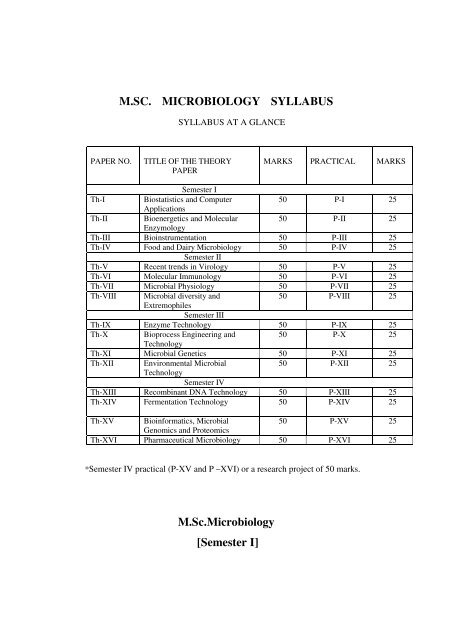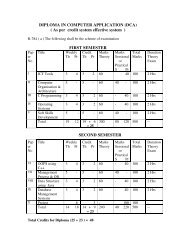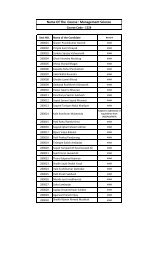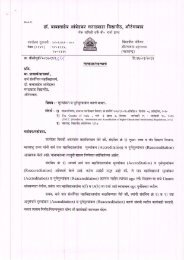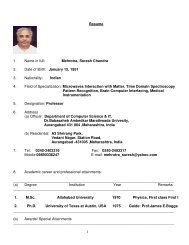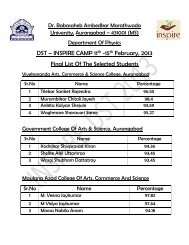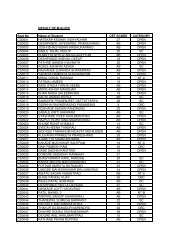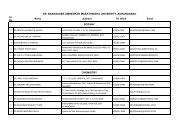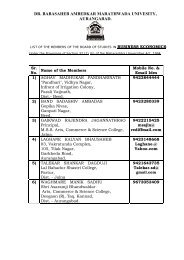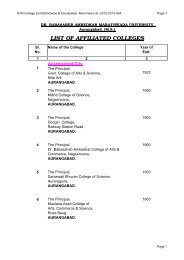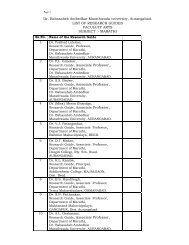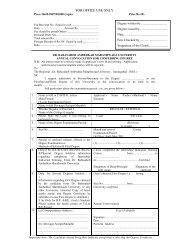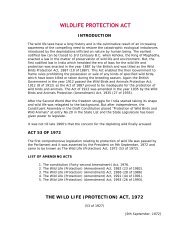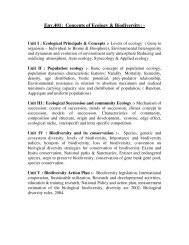M.SC. MICROBIOLOGY SYLLABUS M.Sc.Microbiology
M.SC. MICROBIOLOGY SYLLABUS M.Sc.Microbiology
M.SC. MICROBIOLOGY SYLLABUS M.Sc.Microbiology
Create successful ePaper yourself
Turn your PDF publications into a flip-book with our unique Google optimized e-Paper software.
PAPER NO.<br />
M.<strong>SC</strong>. <strong>MICROBIOLOGY</strong> <strong>SYLLABUS</strong><br />
<strong>SYLLABUS</strong> AT A GLANCE<br />
TITLE OF THE THEORY<br />
PAPER<br />
Semester I<br />
Th-I Biostatistics and Computer<br />
Applications<br />
Th-II Bioenergetics and Molecular<br />
Enzymology<br />
MARKS<br />
PRACTICAL<br />
MARKS<br />
50 P-I 25<br />
50 P-II 25<br />
Th-III Bioinstrumentation 50 P-III 25<br />
Th-IV Food and Dairy <strong>Microbiology</strong> 50 P-IV 25<br />
Semester II<br />
Th-V Recent trends in Virology 50 P-V 25<br />
Th-VI Molecular Immunology 50 P-VI 25<br />
Th-VII Microbial Physiology 50 P-VII 25<br />
Th-VIII Microbial diversity and<br />
Extremophiles<br />
50 P-VIII 25<br />
Semester III<br />
Th-IX Enzyme Technology 50 P-IX 25<br />
Th-X Bioprocess Engineering and<br />
Technology<br />
50 P-X 25<br />
Th-XI Microbial Genetics 50 P-XI 25<br />
Th-XII Environmental Microbial<br />
50 P-XII 25<br />
Technology<br />
Semester IV<br />
Th-XIII Recombinant DNA Technology 50 P-XIII 25<br />
Th-XIV Fermentation Technology 50 P-XIV 25<br />
Th-XV Bioinformatics, Microbial<br />
Genomics and Proteomics<br />
50 P-XV 25<br />
Th-XVI Pharmaceutical <strong>Microbiology</strong> 50 P-XVI 25<br />
*Semester IV practical (P-XV and P –XVI) or a research project of 50 marks.<br />
M.<strong>Sc</strong>.<strong>Microbiology</strong><br />
[Semester I]
PAPER TH-I BIOSTATISTICS AND COMPUTER<br />
APPLICATIONS<br />
Unit –1 Introduction to Biostatistics<br />
Marks 50<br />
Basic definitions and applications. Sampling: Representative sample, sample size, sampling bias<br />
and sampling techniques. Data collection and presentation: Types of data, methods of collection<br />
of primary and secondary data, methods of data presentation, graphical representation by<br />
histogram, polygon, ogive curves and pie diagram.<br />
Unit –2 Measures of central tendency<br />
Measures of central tendency: Mean, Median, Mode.<br />
Measures of variability: Standard deviation, standard error, range, mean deviation and coefficient<br />
of variation. Correlation and regression: Positive and negative correlation and calculation of Karl-<br />
Pearsons co-efficient of correlation. Linear regression and regression equation and multiple linear<br />
regression, ANOVA, one and two way classification.<br />
Calculation of an unknown variable using regression equation.<br />
Unit – 3 Tests of significance<br />
Tests of significance: Small sample test (Chi-square t test, F test), large sample test (Z test) and<br />
standard error.<br />
Introduction to probability theory and distributions, (concept without deviation) binomial, poison<br />
and normal (only definitions and problems)<br />
Computer oriented statistical techniques. Frequency table of single discrete variable, bubble spot,<br />
computation of mean, variance and standard<br />
Deviations, t test, correlation coefficient<br />
Unit- 4 Introduction to computers and computer applications<br />
Introduction to computers: Computer application, basics, organization, PC, mainframes and<br />
Super-computers, concept of hardware and software, concept of file, folders and directories,<br />
commonly used commands, flow charts and programming techniques. Introduction to Q basic and<br />
C. Introduction in MS Office software concerning Word processing, spreadsheets and<br />
presentation software.<br />
Unit - 5 net working concepts<br />
Networking fundamentals, client, server, LAN, WAN, Flp, TelNET, INTERNET, NICNET,<br />
WWW, html, e mail, intoduction to MEDLINE, CCOD and PUBMED, for accessing biological
information. An introduction to bioinorganic software, C/C++, bioperl, biojava, bioXML,<br />
bioORACLE, etc. Introduction to Havard graphics and coral draw.<br />
PRACTICAL<br />
PAPER P-I BIOSTATISTICS AND COMPUTER APPLICATIONS<br />
Marks: 25<br />
1. Representation of Statistical data by<br />
a) Histograms b) Ogive Curves c) Pie diagrams<br />
2. Determination of Statistical averages/ central tendencies.<br />
a) Arithmetic mean b) Median c) Mode<br />
3. Determination of measures of Dispersion<br />
a) Mean deviation<br />
b) b) Standard deviation and coefficient of variation<br />
c) Quartile deviation<br />
4. Tests of Significance-Application of following<br />
a) Chi- Square test b) t- test c) Standard error<br />
5. Computer operations-getting acquainted with different parts of<br />
Computers. [DOS] and basics of operating a computer.<br />
6. Creating files, folders and directories.<br />
7. Applications of computers in biology using MS-Office.<br />
A] MS-Word B] Excel C] Power Point<br />
8. Creating an e-mail account, sending and receiving mails.<br />
9. An introduction to INTERNET, search engines, websites, browsing and<br />
Downloading.<br />
References<br />
1. Statistics in biology, Vol. 1 by Bliss, C.I.K. (1967) Mc Graw Hill, NewYork.<br />
2. Practical Statistics for experimental biologist by Wardlaw, A.C. (1985).<br />
3. Programming in C by E. Ballaguruswamy<br />
4. How Computers work - 2000. By Ron White. Tech. Media<br />
5. How the Internet Work 2000 by Preston Gralla Tech. Media.<br />
6. Statistical Methods in Biology - 2000 by Bailey, N.T. J. English Univ. Press.<br />
7. Biostatistics - 7th Edition by Daniel
8. Fundamental of Biostatistics by Khan<br />
9. Biostatistical Methods by Lachin<br />
10. Statisticsfor Biologist by CampbellR.C. (1974) Cambridge<br />
University Press, UK.<br />
11. INTERNET – CDC publication, India.<br />
PAPER TH-II BIOENERGETICS AND MOLECULAR<br />
ENZYMOLOGY<br />
Marks 50<br />
Unit – 1 Carbohydrate catabolic pathways and microbial growth on C1<br />
Compounds<br />
EMP, HMP, ED, Phosphoketolase pathway, TCA cycle, methylglyoxal bypass. Anaplerotic<br />
sequences, catabolism of different carbohydrates, glycerol metabolism, regulation of<br />
carbohydrate metabolism, Pasteur effect. Substrate level phosphorylation.<br />
Microbial growth on C1 Compounds (Cyanide, Methane, Methanol, methylated amines and<br />
carbon monoxide).<br />
Unit - 2 Bacterial fermentations (biochemical aspects) and Biosynthesis<br />
Alcohol, lactate, mixed acid, butyric acid, acetone-butanol, propionic acid, succinate, methane,<br />
and acetate fermentations. Fermentation of single nitrogenous compounds [amino acids] -<br />
alanine, glutamate and glycine.<br />
Biosynthesis of Purines, Pyrimidines and fatty acids.<br />
Unit – 3 Endogenous metabolism and degradation of aliphatic and aromatic<br />
compounds.<br />
Functions of endogenous metabolism, types of reserve materials, enzymatic synthesis,<br />
degradation and regulation of reserve materials - glycogen, polyphosphates and<br />
polyhydroxybutyrate (PHB), PHB production and its futuristic applications.<br />
Microbial degradation of aliphatic hydrocarbons (microorganisms involved, mon-terminal, bi-<br />
terminal oxidation of propane, decane, etc.) and aromatic hydrocarbons and aromatic compounds<br />
(via catechol, protocatechuate, meta-cleavage of catechol and protocatechuate, dissimilation of<br />
catechol and protocatechuate, homogentisate and other related pathways).<br />
Unit – 4 Properties of Enzymes<br />
Classification of enzymes into six major groups with suitable examples. Numerical classification<br />
of enzymes. Different structural conformations of enzyme proteins. Enzymes as biocatalysts,<br />
catalytic power, activation energy, substrate specificity, active site, theories of mechanisms of<br />
enzyme action. Mechanism of action of lysozyme, chymotrypsin and ribonuclease.
Monomeric, Oligomeric and multienzyme complex, isozymes and allosteric enzymes.<br />
Extremozymes - thermostable, solventogenic and non- aqueous enzymes. Ribozymes and<br />
abzymes<br />
Unit – 5 Enzyme kinetics<br />
Importance of enzyme kinetics, factors affecting rates of enzyme mediated reactions (pH,<br />
temperature, substrate concentration, enzyme concentration and reaction time). Derivation of<br />
Michaelis - Menton equation and its significance in enzyme kinetic studies. Lineweaver-Burke<br />
plot, Haldane-Briggs relationship, sigmoidal kinetics steady state kinetics and transient phases of<br />
enzyme reaction.<br />
PRACTICAL<br />
Paper P-II: BIOENERGETICS AND MOLECULAR<br />
ENZYMOLOGY Marks 25<br />
1. Isolation and Identification of Reserve food material (Glycogen / polyphosphates, PHB)<br />
of B. megaterium and Azotobacter SP.<br />
2. Quantitative estimation of amino acids by Rosen’s method.<br />
3. Quantitative estimation of sugars by Summner’s method.<br />
4. Demonstration of endogenous metabolism in B megaterium or E. coli and their survival<br />
under starvation conditions<br />
5. Quantitative estimation of proteins by Folin-Lowry / Biuret method.<br />
6. Production of fungal alpha amylase using solid-state fermentation/ production of protease<br />
by bacterial species and confirmation by determining the achromic point.<br />
7. Purification of fungal alpha-amylase or bacterial protease by fractionation,<br />
chromatographic techniques and electrophoretic separation.<br />
8. Studies on enzyme kinetics of alpha amylase/Protease [Optimization of parameters viz.<br />
References<br />
Substrate, enzyme concentration, reaction temperature, reaction pH, Km, Vmax and<br />
metal ions as activators and inhibitors).<br />
1. Understanding Enzymes by Trevor Palmer<br />
2. Enzyme Kinetics by Paul Engel. 1977. John Wiley and Sons. Inc., New<br />
York.<br />
3. Enzymes by Dixon and Webb, 3 rd Edition 1979. Academic Press, New York
4. Biochemistry by Stryer 5th Edition WH Freeman 2001<br />
5. Laboratory techniques in Biochemistry and Molecular Biology by Work and Work.<br />
6. Principles of Enzyme Kinetics. 1976. By Athel Cornish - Bowden.<br />
Butterworth and Co.<br />
7. Fundamentals of Enzymology. 3rd Edition by Price<br />
8. Biochemistry by Chatwal<br />
9.Methods in Enzymology by Drolittle<br />
10.Biochemistry by Garrett<br />
11. Principles of Biochemistry. 2 nd Edition by Horton<br />
12. Biochemistry by Voet.<br />
13. Methods of Biochemical Analysis by David Glick, John Wiley and Sons, New York.<br />
PAPER TH-III BIOINSTRUMENTATION Marks 50<br />
Unit –1 Basic laboratory Instruments<br />
Principle and working of pH meter, Laminar-air flow. Centrifugation: Types of centrifuge<br />
machines, preparative and analytical centrifuges, differential centrifugation, sedimentation<br />
velocity, sedimentation equilibrium, density gradient methods and their applications.<br />
Unit – 2 Chromatographic techniques<br />
Theory, principles and applications of paper, thin layer, gel filtration, ion exchange, affinity,<br />
hydrophobic, gas liquid, high pressure/ performance liquid chromatography (HPLC)<br />
Unit – 3 Electrophoretic techniques<br />
Basic principles of electrophoresis, theory and application of paper, starch gel, agarose, native<br />
and denaturing PAGE, isoelectric focusing.<br />
Unit – 4 Spectroscopy<br />
Spectroscopic techniques, theory and applications of Uv, Visible, IR, NMR, Fluorescence,<br />
Atomic Absorption, CD, ORD, Mass, Raman Spectroscopy.<br />
Unit – 5 Radioisotopic techniques<br />
Use of radioisotopes in life sciences, radioactive labeling, principle and application of tracer<br />
techniques, detection and measurement of radioactivity using ionization chamber, proportional<br />
chamber, Geiger- Muller and <strong>Sc</strong>intillation counters, autoradiography and its applications.<br />
Dosimetry.
PRACTICAL<br />
PAPER P-III BIOINSTRUMENTATION Marks<br />
25<br />
1. Studies on pH titration curves of amino acids/ acetic acid and determination of pKa<br />
values and Handerson-Hasselbach equation.<br />
2. Separation of bacterial lipids/amino acids/sugars/organic acids by TLC or Paper<br />
Chromatography.<br />
3. Separation of serum protein by horizontal submerged gel electrophoresis.<br />
4. Study of UV absorption spectra of macromolecules (protein, nucleic acid, bacterial<br />
pigments).<br />
5. Quantitative estimation of hydrocarbons/pesticides/organic<br />
Solvents /methane by Gas chromatography.<br />
6. Demonstration of PCR, DNA sequencer and Fermenter.<br />
7. Separation of haemoglobin or blue dextran by gel filtration.<br />
8. Paper electrophoresis.<br />
9. Friske dosimetry.<br />
References<br />
1. Instrumental Methods of Analysis. 6th Edition by H.H. Willard, L.L. Merritt Jr. and<br />
others. 1986. CBS Publishers and Distributors.<br />
2. Instrumental Methods of Chemical Analysis. 1989 by Chatwal G and Anand, S.<br />
Himalaya Publishing House, Mumbai.<br />
3. A Biologists Guide to Principles and Techniques of Practical Biochemistry. 1975 by<br />
Williams, B.L. and Wilson, K.<br />
4. Spectroscopy. Volume 1. Edited by B.B. Straughan and S. Walker. Chapman and Hall<br />
Ltd.<br />
5. Gel Electrophoresis of Proteins- A Practical Approach by Hanes.<br />
6. Chromatography: Concepts and Contrasts- 1988 by James Miller. John Wiley and Sons.<br />
Inc., New York.<br />
7. Analytical Biochemistry by Holme.<br />
8. Introduction to High Performance Liquid Chromatography by R. J. Hamilton and P. A.<br />
Sewell.<br />
9. Spectroscopy by B.P. Straughan and S. Walker.
10. Practical aspects of Gas Chromatography and Mass Spectrometry 1984 by Gordon M.<br />
Message, John Wiley and Sons, New York.<br />
11. Gel Chromatography by Tibor Kremmery. Wiley Publications.<br />
12. Isotopes and radiations in Biology by C.C. Thornburn, Butterworth and Co. Ltd.,<br />
London.<br />
13. The use of radioactive isotopes in the life sciences by J.M.Chapman and G.Ayrey,<br />
George Allen and Unwin Ltd., London.<br />
PAPER TH-IV FOOD AND DAIRY <strong>MICROBIOLOGY</strong><br />
Unit – 1 Industrial Food fermentations<br />
Marks 50<br />
Starter cultures their biochemical activities, production and preservation of the following<br />
fermented foods.<br />
a. Soy sauce fermentation by Moulds<br />
b. Fermented vegetables – Saurkraut<br />
c. Fermented Meat – Sausages<br />
d. Production and application of Bakers Yeast<br />
e. Application of microbial enzymes in food industry<br />
Unit – 2 Quality assurances in foods<br />
Foodborne infections and intoxications; bacterial with examples of infective and toxic types –,<br />
Clostridium, Salmonella, Shigella, Staphylococcus, Campylobacter, Listeria.<br />
Mycotoxins in food with reference to Aspergillus species.<br />
Quality assurance: Microbiological quality standards of food. Government regulatory practices<br />
and policies. FDA, EPA, HACCP, ISI.<br />
Unit –3 Food preservation methods<br />
Radiations - UV, Gamma and microwave<br />
Temperature<br />
Chemical and naturally occurring antimicrobials<br />
Biosensors in food industry.<br />
UNIT – 4 <strong>Microbiology</strong> of cheese and beverage fermentation.<br />
<strong>Microbiology</strong> of fermented milk products (acidophilus milk, yoghurt).<br />
Role of microorganisms in beverages – tea and coffee fermentations.<br />
Vinegar Fermentation
Unit - 5 Advanced Food <strong>Microbiology</strong><br />
Genetically modified foods. Biosensors in food, Applications of microbial enzymes in dairy<br />
industry [Protease, Lipases].<br />
Utilization and disposal of dairy by-product - whey.<br />
PRACTICAL<br />
PAPER - P-IV FOOD AND DAIRY <strong>MICROBIOLOGY</strong> Marks 25<br />
1. Production and estimation of lactic acid by Lactobacillus Sp.<br />
Or Streptococcus Sp.<br />
2. Extraction and estimation of diacetyl.<br />
3. Sauerkraut fermentation<br />
4. Isolation of food poisoning bacteria from contaminated foods,<br />
Dairy products<br />
5. Extraction and detection of afla toxin for infected foods.<br />
6. Preservation of potato/onion by UV radiation<br />
7. Production of fermented milk by Lactobacillus acidophilus.<br />
8. Rapid analytical techniques in food quality control using microbial<br />
References<br />
Biosensors.<br />
1. Food <strong>Microbiology</strong>. 2nd Edition By Adams<br />
2. Basic Food <strong>Microbiology</strong> by Banwart George J.<br />
3. Food <strong>Microbiology</strong>: Fundamentals and Frontiers by Dolle<br />
4. Biotechnology: Food Fermentation <strong>Microbiology</strong>, Biochemistry and Technology.<br />
Volume 2 by Joshi.<br />
5. Fundamentals of Dairy <strong>Microbiology</strong> by Prajapati.<br />
6. Essentials of Food <strong>Microbiology</strong>. Edited by John Garbult. Arnold International Students<br />
Edition.<br />
7. <strong>Microbiology</strong> of Fermented Foods. Volume II and I. By Brian J. Wood.Elsiever Applied<br />
<strong>Sc</strong>ience Publication.<br />
8. <strong>Microbiology</strong> of Foods by John C. Ayres. J. Orwin Mundt. William E. Sandinee. W. H.<br />
Freeman and Co.<br />
9. Dairy <strong>Microbiology</strong> by Robinson. Volume II and I.
10. Food <strong>Microbiology</strong>: Fundamentals and Frontiers. 2nd Edition by Michaell P. Doyle,<br />
Larry R. Beuchat and Thomas I. Montville (Eds.), ASM Publications.<br />
11. Bacterial Pathogenesis A Molecular Approach. 2 nd Edition. 2001 by Abigail A.Salyers<br />
and Dixie D. Whitt. ASM Publications.<br />
12. Advances in Applied <strong>Microbiology</strong> by D. Pearlman, Academic Press.<br />
[ SEMESTER II ]<br />
PAPER TH-V RECENT TRENDS IN VIROLOGY Marks 50<br />
Unit –1 Classification and Morphology of Viruses<br />
Cataloging the virus through virus classification schemes of ICTV / ICNV. Morphology and<br />
ultra-structure of viruses. Virus related agents, viroids and prions.<br />
Unit – 2 Cultivation and assay of viruses<br />
Cultivation of viruses using embryonated eggs, experimental animals and cell cultures (Cell-lines,<br />
cell strains and transgenic systems). Purification of viruses by adsorption, precipitation, enzymes,<br />
serological methods – haeme agglutination and ELISA.<br />
Assay of viruses – Physical and Chemical methods (Electron Microscopy and Protein and<br />
Nucleic acids studies.)<br />
Infectivity Assays (Plaque and end-point)<br />
Genetic analysis of viruses by classical genetic methods.<br />
Unit – 3 Viral Multiplication<br />
Mechanism of virus adsorption and entry into the host cell including genome replication and<br />
mRNA production by animal viruses, mechanism of RNA synthesis, mechanism of DNA<br />
synthesis, transcription mechanism and post transcriptional processing, translation of viral<br />
proteins, assembly, exit and maturation of progeny virions, multiplication of bacteriophages.<br />
Unit – 4 Pathogenesis of Viruses<br />
Host and virus factors involved in pathogenesis, patterns of infection, pathogenesis of animal<br />
viruses Adenovirus, Herpes virus, Hepatitis virus, Picorna virus, Poxvirus and Orthomyxovirus,<br />
pathogenesis of plant [TMV] and insect viruses [NPV]. Host cell transformation by viruses and<br />
oncogenesis of DNA and RNA viruses.<br />
Unit – 5 Control of Viruses and Emerging Viruses
Control of viral infections through vaccines, interferons and chemotherapeutic agents.<br />
Structure, genomic organization, pathogenesis and control of Human immunodeficiency virus.<br />
Emerging viruses<br />
25<br />
PRACTICAL<br />
PAPER - P-V RECENT TRENDS IN VIROLOGY Marks<br />
1. One step growth curve for determination of virus titre.<br />
2. Phage typing of E.coli bacteriophages.<br />
3. Induction of lambda lysogen by UV radiations.<br />
4. Studies on Specialized transduction<br />
5. Isolation of lambda DNA and their characterization.<br />
6. Amplification of lambda DNA by PCR<br />
7. Cultivation and assay of viruses using embryonated eggs and Tissue culture Technique.<br />
References<br />
1. Medical Virology 10 Th Edition by Morag C and Tim bury M C 1994. Churchil<br />
Livingstone, London.<br />
2. Introduction to Modern Virology 4th Edition by Dimmock N J, Primrose S. B. 1994.<br />
Blackwell <strong>Sc</strong>ientific Publications. Oxford.<br />
3. Virology 3 rd Edition by Conrat H.F., Kimball P.C. and Levy J.A. 1994. Prentice Hall,<br />
Englewood Cliff, New Jersey.<br />
4. Text Book on Principles of Bacteriology, Virology and Immunology Topley and Wilsons<br />
1995.<br />
5. Molecular Biology, Pathogenesis and Control by S.J. Flint and others. ASM Press,<br />
Washington, D.C.<br />
6. Applied Virology. 1984. Edited by Edonard Kurstak. Academic Press Inc.<br />
7. Introduction to Modern Virology by Dimmock.<br />
8. Prion diseases by Gaschup, M.H.<br />
9.Clinical virology Manual by Steven, S., Adinka, R.L., Young, S.A.<br />
10. Principles of Virology. 2000 by Edward Arnold.
PAPER TH-VI MOLECULAR IMMUNOLOGY Marks 50<br />
Unit – 1 Immune System<br />
Organs and cells involved in immune system and immune response. Lymphocytes, their<br />
subpopulation, their properties and functions, membrane bound receptors of lymph cells, helper T<br />
cells, T cells suppression, lymphocyte trafficking.<br />
Unit – 2 Antigens and Immunoglobulins<br />
Concept of haptens, determinants, conditions of antigenicity, antigens and immunogenecity,<br />
superantigen.<br />
Immunoglobulins: Structure and properties of immunoglobulin classes. Theories of antibody<br />
formation, hybridoma technology for monoclonal antibodies and designer monoclonal antibodies.<br />
Multiple mylomas and structural basis of antibody diversity. Freund’s adjuvants and its<br />
significance.<br />
Unit – 3 Antigen – Antibody reactions<br />
Antigen-Antibody reaction by precipitation, agglutination and complement fixation.<br />
Non-specific immune mechanism: - Surface defenses, tissue defenses, opsonization, inflamatory<br />
reaction, and hormone balance.<br />
Tissue metabolites with bactericidal properties (lysozyme, nuclein, histone, protamine, basic<br />
peptides of tissues – leukins, phagocytins, lecterins, haemocompounds)<br />
Unit – 4 Expressions and Regulation of Immune Response<br />
Regulation of immune response: antigen processing and presentation, generation of humoral and<br />
cell mediated immune response, activation of B and T lymphocytes, cytokines and their role in<br />
immune regulation, T cell regulation, MHC restriction, immunological tolerance. Cell mediated<br />
cytotoxicity: Mechanism of T cells and NK mediated lysis, antibody dependent cell mediated<br />
cytotoxicity, and macrophage mediated cytotoxicity.<br />
Complement system: Classical, alternate, lectin pathway of complement activation. Regulation of<br />
complement activation.<br />
Transplantation immunology: MHC, types of grafts, grafts rejection, GVH reactions, mechanism<br />
of graft rejection, and prevention of graft rejection.
Unit - 5: Immunity and Immunoassays<br />
Defense against bacteria, viruses, fungi and parasites. Immunodiagnostics and immunotherapy in<br />
virology – Serological methods for detection and quantitation of viruses including Hepatitis,<br />
Influenza, HIV and others.<br />
Immuno-assays: SRID, ELISA, ELISA-PCR, RIA, Western Blotting, Immunofluroscens and<br />
their application. Immune deficiencies and autoimmunity.<br />
PRACTICAL<br />
PAPER P-VI MOLECULAR IMMUNOLOGY Marks 25<br />
1. Diagnostic immunologic principles and methods<br />
Precipitation method - Immunodiffusion<br />
Agglutination method - Widal test<br />
- Immunoelectrophoresis<br />
- Haemagglutination<br />
- ELISA method<br />
2. Separation of serum protein by submerged agarose gel electrophoresis.<br />
3. Purification of human immunoglobulins from serum and confirmation of its antigenicity.<br />
4. Identification of S.typhi by serotyping. [Purification of H and O antigens from S.typhi]<br />
5. Clinical diagnosis of Rheumatoid arthritis by purifying immunoglobulins and albumins<br />
and confirmation by lattice agglutination test.<br />
6. Estimation of Alkaline phosphatase from patient’s serum.<br />
7. Demonstration of Western blotting.<br />
8. Detection of isozymes of Lactate dehydrogenase by PAGE<br />
9. Clinical diagnosis of viral diseases by PCR, ELISA.<br />
References<br />
1. Essentials of Immunology by Riott I .M. 1998. ELBS, Blackwell <strong>Sc</strong>ientific Publishers,<br />
London.<br />
2. Immunology 2 nd Edition by Kuby J. 1994. W.H. Freeman and Co. New York.<br />
3. . Immunology - Understanding of Immune System by Claus D. Elgert. 1996. Wiley -<br />
Liss, New York.<br />
4. Fundamentals of Immunology by William Paul.
5. Cellular and Molecular Immunology. 3rd Edition by Abbas.<br />
6. Immunobiology: The Immune System in Health and Disease. 3rd Edition by Travers.<br />
7. Immunology- A short Course. 2 nd Edition by Benjamin.<br />
8. Manual of Clinical Laboratory and Immunology 6th Edition. 2002 by Noel R. Rose,<br />
Chief Editor: Robert G. Hamilton and Barbara Detrick (Eds.) , ASM Publications.<br />
9. Pocket Guide to Clinical <strong>Microbiology</strong>. 2 nd Edition. 1998 by Patrick R. Murray, ASM<br />
Publications.<br />
PAPER TH-VII MICROBIAL PHYSIOLOGY Marks 50<br />
Unit – 1 Bacterial photosynthesis<br />
Photosynthetic microorganisms, photosynthetic pigments, and generation of reducing power by<br />
cyclic and non-cyclic photophosphorylation, electron transport chain in photosynthetic bacteria.<br />
Carbon dioxide fixation pathways.<br />
Unit – 2 Bacterial Respiration<br />
Bacterial aerobic respiration, components of electron transport chain, free energy changes and<br />
electron transport, oxidative phosphorylation and theories of ATP formation, inhibition of<br />
electron transport chain. Electron transport chain in some heterotrophic and chemolithotrophic<br />
bacteria.<br />
Bacterial anaerobic respiration: Introduction. Nitrate, carbonate and sulfate as electron acceptors.<br />
Electron transport chains in some anaerobic bacteria. Catalase, super oxide dismutase, mechanism<br />
of oxygen toxicity.<br />
Unit – 3 Bacterial Permeation<br />
Structure and organization of membrane<br />
(Glyco-conjugants and proteins in membrane systems), fluid mosaic model of membrane.<br />
Methods to study diffusion of solutes in bacteria, passive diffusion, facilitated diffusion, different<br />
mechanisms of active diffusion (Proton Motive Force, PTS, role of permeases in transport,<br />
different permeases in E. coli. Transport of aminoacids and inorganic ions in microorganisms and<br />
their mechanisms.<br />
Unit – 4 Bacterial Sporulation
Sporulating bacteria, molecular architecture of spores, induction and stages of sporulation,<br />
Influence of different factors on sporulation. Cytological and macromolecular changes during<br />
sporulation. Heat resistance and sporulation.<br />
Unit –5 Bacterial Chemolithotrophy<br />
Physiological groups of chemolithotrophs, ammonia oxidation by members of Genus Nitroso<br />
group, nitrite oxidation by Nitro group of genera. Oxidation of molecular hydrogen by<br />
Hydrogenomonas species. Ferrous and sulfur/sulfide oxidation by Thiobacillus species.<br />
PRACTICAL<br />
PAPER P-VII MICROBIAL PHYSIOLOGY Marks 25<br />
1. Isolation of Photosynthetic bacteria<br />
2. Glucose uptake by E. coli / Saccharomyces cerevisiae [Active and Passive diffusion]<br />
3. Effect of UV, gamma radiations, pH, disinfectants, chemicals and heavy metal ions on<br />
spore germination of Bacillus SP.<br />
4. Determination of Iron Oxidation Rate of Thiobacillus ferrooxidans.<br />
5. Determination of Sulfur Oxidation Rate of Thiobacillus thiooxidans.<br />
6. Microbial degradation, decolorization and adsorption of organic dyes (by free and<br />
immobilized cells).<br />
7. Estimation of calcium ions present in sporulating bacteria by EDTA method.<br />
8. Demostration of utilization of sugars by oxidation and fermentation techniques.<br />
References<br />
1. Microbial Physiology and Metabolism by Caldwell D.R. 1995Brown Publishers.<br />
2. Microbial Physiology by Moat A.G. and Foster J. W. 1999.. Wiley.<br />
3. . Prokaryotic Development by Brun. Y.V. and Shimkets L.J. 2000. ASM Press.<br />
4. Advances in Microbial Physiology. Volumes. Edited by By A.H. Rose. Academic Press,<br />
New York.<br />
5. Applied Microbial Physiology by Rhodes.<br />
6. Biosynthesis by Smith.<br />
7. The Bacteria. Volumes by I.C. Gunsalus and Rogery Stanier, Acadenic Press.<br />
8. Microbial Physiology by Benjamin
PAPER TH-VIII : MICROBIAL DIVERSITY AND<br />
EXTREMOPHILES<br />
Unit - 1 Biodiversity<br />
Marks 50<br />
Introduction to microbial biodiversity – distribution, abundance, ecological niche. Types-<br />
Bacterial, Archael and Eucaryal.<br />
Unit – 2 Characteristics and classification of Archaebacteria.<br />
Thermophiles: Classification, hyperthermophilic habitats and ecological aspects. Extremely<br />
Thermophilic Archaebacteria, Thermophily, commercial aspects of thermophiles. Applications of<br />
thermozymes.<br />
Methanogens: Classification, Habitats, applications.<br />
Unit – 3 Alkalophiles and Acidophiles<br />
Classification , alkaline environment , soda lakes and deserts , calcium alkalophily Applications .<br />
Acidophiles: Classification, life at low pH, acidotolerence, applications.<br />
Unit – 4 Halophiles and Barophiles<br />
Classification, Dead Sea, discovery basin, cell walls and membranes – Purple membrane,<br />
compatible solutes. Osmoadaptation / halotolerence. Applications of halophiles and their<br />
extremozymes.<br />
Barophiles: Classification, high-pressure habitats, life under pressure, barophily, death under<br />
pressure.<br />
Unit – 5 Space <strong>Microbiology</strong><br />
Aims and objectives of Space research. Life detection methods a] Evidence of metabolism<br />
(Gulliver) b] Evidence of photosynthesis (autotrophic and heterotrophic) c] ATP production d]<br />
Phosphate uptake e] Sulphur uptake . Martian environment (atmosphere, climate and other<br />
details).<br />
Antartica as a model for Mars. Search for life on Mars, Viking mission, Viking landers, and<br />
Biology box experiment. Gas exchange , Label release and pyrolytic release experiments .<br />
Monitoring of astronauts microbial flora: Alterations in the load of medically important<br />
microorganisms, changes in mycological autoflora, and changes in bacterial autoflora.<br />
PRACTICAL<br />
PAPER- P-VIII MICROBIAL DIVERSITY AND EXTREMOPHILES<br />
Marks 25
1. Isolation of thermophiles from hot water spring [Study at least one enzyme].<br />
2. Studies on halophiles isolated from seawater. [Pigmentation and Salt tolerance]<br />
3. Studies on alkalophiles isolated from lonar water/sea water. [Study at least one enzyme]<br />
4. Biogenic methane production using different wastes.<br />
5. Isolation of Thiobacillus ferrooxidans and Thiobacillus thiooxidans cultures from metal<br />
sulfides, rock coal and acid mine waters.<br />
Reference<br />
1. Extremophiles by Johri B.N. 2000. Springer V erlag. , New York<br />
2. Microbial Diversity by Colwd , D. 1999, Academic Press.<br />
3. MIcrobial Life in Extreme Environments. Edited by D. J. Kushner. Academic Press.<br />
4. <strong>Microbiology</strong> of Extreme Environments. Edited by Clive Edward. Open University Press.<br />
Milton Keynes.<br />
5. <strong>Microbiology</strong> of Extreme Environments and its potential for Biotechnology. Edited by<br />
M.S. Da Costa, J.C. Duarate, R.A. D. Williams. Elsiever Applied <strong>Sc</strong>ience, London.<br />
6. Extreme Environment. Mechanism of Microbial Adaptation. Edited by Milton R.<br />
Heinrich. Academic Press.<br />
7. Thermophiles. General, Molecular and Applied <strong>Microbiology</strong>. Edited by Thomas D.<br />
Brock. Wiley Interscience Publication.<br />
8. <strong>Microbiology</strong>: Dynamics and Diversity by Perry.<br />
9. Microbial Ecology. Fundamentals and Applications by. Ronald M. Atlas and Richard<br />
Bartha. 2nd and 4th Edition. The Benjamin Cummins Publication Co. Inc.<br />
10. Microbial Ecology. 2nd Edition. by R. Campbell. Blackwell <strong>Sc</strong>ientifc Publication.<br />
11. Brocks Biology of Microorganisms. 8th Edition. (International Edition - 1997) by<br />
Michael T. Madigan, John M. Martinko. Jack Parker. Prentice Hall Internation Inc.<br />
12. Advances in Applied <strong>Microbiology</strong>. Vol. 10. Edited by Wayne W. Umbreit and D.<br />
Pearlman. Academic Press.<br />
[ Semester III ]<br />
PAPER TH-IX ENZYME TECHNOLOGY Marks 50
Unit – 1 Extraction and purification of microbial enzymes<br />
Importance of enzyme purification, different sources of enzymes. Extracellular and intracellular<br />
enzymes. Physical and Chemical methods used for cell disintegration. Enzyme fractionation by<br />
precipitation (using Temperature, salt, solvent, pH, etc.), liquid-liquid extraction, ionic exchange,<br />
gel chromatography, affinity chromatography and other special purification methods. Enzyme<br />
crystallization techniques. Criteria of purity of enzymes. Pitfalls in working with pure enzymes.<br />
Unit - 2 Enzyme inhibition and Co-factors<br />
Irreversible, reversible, competitive, non-competitive and un-competitive inhibition with suitable<br />
examples and their kinetic studies.<br />
Allosteric inhibition, types of allosteric inhibition and their significance in metabolic regulation<br />
& their kinetic study Vitamins and their co-enzymes: structure and functions with suitable<br />
examples Metalloenzymes and Metal ions as co-factors and enzyme activators.<br />
Unit - 3 Immobilization of microbial enzymes<br />
Methods viz. adsorption, covalent bonding, entrapment & membrane confinement and their<br />
analytical, therapeutic & industrial applications. Properties of immobilized enzymes.<br />
Unit – 4 Enzyme Engineering<br />
Chemical modification and site-directed mutagenesis to study the structure-function relationship<br />
of industrially important enzymes.<br />
Unit – 5 Applications of microbial enzymes<br />
Microbial enzymes in textile, leather, wood industries and detergents. Enzymes in clinical<br />
diagnostics.<br />
Enzyme sensors for clinical processes and environmental analyses . Enzymes as therapeutic<br />
agents.<br />
PRACTICAL<br />
PAPER -P-IX ENZYME TECHNOLOGY Marks 25<br />
1. Microbial production , Extraction , purification and Confirmation of alpha amylase/<br />
Lipase<br />
2. Determination of efficiency of enzyme purification by measuring specific activity at<br />
various stages viz. Salt precipitation, dialysis, electrophoresis etc.<br />
3. Studies on enzyme Activation and Inhibition of extracted alpha amylase /Lipase .Effect<br />
of Heavy metal ions, Chelating agents activators and inhibitors<br />
4. Immobilization of cells and enzyme using Sodium alginate and egg albumin and
measurement of enzyme activity [ amylase/ /Lipase ]<br />
5 . Studies on impact of immobilization on enzyme activity in terms of<br />
Temperature tolerance and Vmax and Km using various forms<br />
Of alpha amylase/Lipase<br />
6. Determination of molecular weight of enzymes using<br />
PAGE technique.<br />
7. Preparation of biosensors of urease and determination of its activity.<br />
References<br />
1. Methods in Enzymology. Volume 22 - Enzyme purification and related techniques.<br />
Edited by William B. Jakoby. Academic Press, New York.<br />
2. Allosteric Enzymes - Kinetic Behaviour. 1982. by B.I. Kurganov. John Wiley and Sons.<br />
Inc., New York.<br />
3. Biotechnology. Volume 7 A - Enzymes in Biotechnology. 1983 Edited by H. J. Rehm<br />
and G. Reed. Verlag Chemie.<br />
4. Hand Book of Enzyme Biotechnology by Wiseman.<br />
5. Enzymes as Drugs Edited by John S.Holcenberg and Joseph Roberts , John Wiley & Sons<br />
New York.<br />
6. Methods of Enzymatic Analysis by Hans Ulrich, Bergmeyer, Academic Press.<br />
7. Methods in Enzymology by W.A. Wood, Academic Press.<br />
8. Advances in Enzymology by Alton Meister, Interscience Publishers.<br />
9. Topics in Enzyme and Fermentation Biotechnology by L.N. Wiseman, John Wiley and<br />
Sons.<br />
PAPER -TH X BIOPROCESS ENGINEERING AND<br />
TECHNOLOGY<br />
Marks 50<br />
Unit–1 Bioreactors<br />
Design of a basic fermenter, bioreactor configuration, design features, individual parts, baffles,<br />
impellers, foam separators, sparger, culture vessel, cooling and heating devices, probes for on-<br />
line monitoring, computer control of fermentation process, measurement and control of process.<br />
Reactors for specialized applications: Tube reactors, packed bed reactors, fluidized bed reactors,<br />
cyclone reactors, trickle flow reactors, their basic construction and types for distribution of gases.<br />
Unit – 2 Mass transfer in reactors<br />
Transport phenomena in fermentation: Gas- liquid exchange and mass transfer, oxygen transfer,
critical oxygen concentration, determination of Kla, heat transfer, aeration/agitation, its<br />
importance.<br />
Sterilization of Bioreactors, nutrients, air supply, products and effluents, process variables and<br />
control, scale-up of bioreactors.<br />
Unit – 3 Fermentation process<br />
Growth of cultures in the fermenter Importance of media in fermentation, media formulation and<br />
modification .<br />
Kinetics of growth in batch culture, continuous culture with respect to substrate utilization,<br />
specific growth rate, steady state in a chemostat, fed-batch fermentation, yield of biomass,<br />
product, calculation for productivity, substrate utilization kinetics.<br />
Fermentation process: Inoculum development. Storage of cultures for repeated fermentations,<br />
scaling up of process form shake flask to industrial fermentation.<br />
Unit – 4 Down stream processing<br />
Biomass separation by centrifugation, filtration, flocculation and other recent developments.<br />
Cell disintegration: Physical, chemical and enzymatic methods.<br />
Extraction: Solvent, two phase, liquid extraction, whole broth, aqueous multiphase extraction.<br />
Purification by different methods.<br />
Concentration by precipitation, ultra-filtration, reverse osmosis.<br />
Drying and crystallization.<br />
Unit - 5 Microbial strain improvement<br />
Isolation, selection and improvement of microbial cultures: <strong>Sc</strong>reening and isolation of<br />
microorganisms, primary and secondary metabolites, enrichment, specific screening for the<br />
desired product.<br />
Strain improvement for the selected organism: mutation and screening of improved cultures,<br />
random and strategic screening methods, strategies of strain improvement for primary, secondary<br />
metabolites with relevant examples. Use of recombinant DNA technology, protoplast fusion<br />
techniques for strain improvement of primary and secondary metabolites.<br />
Production of recombinant molecules in heterologus system, problems associated with strain<br />
improvement programme, improvement of characters other than products and its application in<br />
the industry.<br />
Preservation of cultures after strain improvement programme.<br />
PRACTICAL
PAPER -P-X : BIOPROCESS ENGINEERING AND TECHNOLOGY<br />
Marks 25<br />
1. Isolation of industrially important microorganisms for microbial processes (citric / lactic/<br />
alpha amylase) and improvement of strain for increase yield by mutation.<br />
2. Determination of Thermal Death Point (TDP) and Thermal Death Time (TDT) of<br />
microorganisms for design of a sterilizer.<br />
3. [a] Determination of growth curve of a supplied microorganism and also determines<br />
substrate degradation profile.<br />
[b] Compute specific growth rate (m), growth yield (Y x/s) from the above.<br />
4. Extraction of Citric acid/Lactic acid by salt precipitation.<br />
5. Monitoring of dissolved oxygen during aerobic fermentation.<br />
6. Preservation of industrially important bacteria by lyophilization.<br />
7. Product concentration by vacuum concentrator<br />
8 Cell disruption for endoenzymes by sonication.<br />
References<br />
1. Principles of Fermentation Technology by Stanbury, P.F., Whitekar A. and Hall. 1995.,<br />
Pergaman. McNeul and Harvey.<br />
2. Fermentations - A practical approach. IRL.<br />
3. Bioprocess Technology: Fundamentals and Applications. Stockholm KTH.<br />
4. Biochemical Reactors by Atkinson B., Pion, Ltd. London.<br />
5. Biotechnology - A Text Book of Industrial <strong>Microbiology</strong> by Cruger.<br />
6. Fermentation Biotechnology: Industrial Perspectives by Chand.<br />
7. Biochemical Engineering Fundamentals by Bailey and Ollis, Tata McGraw Hill, N.Y.<br />
8. Biotechnology. Volume 3. Edited by H. J. Rehm and G. Reed. Verlag Chemie. 1983.<br />
9. Advances in Biochemical Engineering by T.K. Bhosh, A.Fiechter and N. Blakebrough.<br />
Springer Verlag Publications, New York.<br />
10. Biotechnology- A textbook of Industrial <strong>Microbiology</strong> by Creuger and Creuger, Sinaeur<br />
Associates.<br />
11. Bioprocess Engineering Kinetics, Mass Transport, Reactors, and Gene expressions by<br />
Veith, W.F., John Wiley and Sons.<br />
12. Applied <strong>Microbiology</strong> Series.<br />
13. Industrial <strong>Microbiology</strong> by L.E. Casida, Wiley Eastern<br />
14. Bioseparation: Down stream processing for Biotechnology by Belter, P.A. Cussler, E.L.
and Hu, W.S., John Wiley and Sons, N.Y.<br />
15. Separation process in Biotechnolgy by Asenjo, J.A. Eds. Marcel Dekkar, N.Y.<br />
16. Bioprocess Engineering Principles by Doran, Acad. Press, London.<br />
17. Bioreaction Engineering Principles by Nielsen, J. and Villadsen, plenum Press, N.Y.<br />
18. Fermentation, Biocatalysis and bioseparation, Encyclopedia of Bioprocess Technology<br />
by Chisti, Y., Vol. 5, John Wiley and Sons, N, Y.<br />
PAPER TH-XI MICROBIAL GENETICS Marks 50<br />
Unit – 1 DNA Structure and Mutagenesis<br />
Historical developments in genetics, discovery of DNA and experimental evidence, Structure of<br />
Circular DNA molecule, Primary, Secondary, Tertiary and Quaternary structure of DNA, Watson<br />
and Crick model of double stranded DNA the law of DNA constancy and C value paradox and<br />
topological manipulations.<br />
DNA replication: DNA replication mechanism, enzymes involved in DNA replication and models<br />
of DNA replication.<br />
Molecular basis of spontaneous and induced mutations [physical and chemical mutagenic agents],<br />
types of mutation: point, frameshift, lethal, conditional lethal, inversion and deletion, null<br />
mutation, reversion of mutations, intra and intergenic suppression mutations. Environmental<br />
mutagenesis, toxicity testing and population genetics.<br />
Systems that safeguard DNA. DNA methylation and DNA repair mechanisms - excision, mis-<br />
match, SOS , photoreactivation, recombination repair and glycocylase system.<br />
Unit – 2 Prokaryotic Transcription and Translation<br />
Organization of transcriptional units and regulation of gene expression Mechanism of<br />
transcription of prokaryotes-Structure and function of RNA polymerase, [DNA foot printing],<br />
termination and antitermination – N proteins and nut sites in DNA binding proteins, enhancer<br />
sequences and control of transcription, RNA processing (Capping, polyadenylation, splicing,<br />
introns and exons) Ribonucleoprotein, structure of mRNA, rRNA, tRNA. Direction of protein<br />
synthesis, RNA template, direction with experimental proof, tRNA as adaptor, ribosomes and<br />
their organization in prokaryotes, polycistronic mRNA in bacteria, initiation of translation in<br />
bacteria, small sub-units, its accessory factors, SD sequence in bacteria, initiator tRNA,<br />
elongation of translation, translocation and termination mechanisms. Post-translational<br />
modification. Salient features of genetic code.<br />
Unit – 3 Regulation of gene expression in prokaryotes<br />
Operon concept, co-ordinated control of structural genes, stringent response, catabolite
epression, instability of bacterial RNA, positive regulation in E.coli [Arabinose operon] and<br />
negative regulation in E.coli [lac operon], inducers and repressors, regulation by attenuation by<br />
trp operon.<br />
Unit - 4 Genetic recombination<br />
Genetic recombination processes: Role of rec proteins in homologous recombination.<br />
Conjugation: Discovery, F + , F - and Hfr cells, types of Hfr; F + and F - and Hfr and F - genetic<br />
crosses. Mechanism of conjugation. Sexduction, conjugational transfer of colicinogenic and<br />
resistance transfer factors. Genetic mapping. Plasmid Replication and Incompitability, Control of<br />
copy number.<br />
Transposons – Insertion sequences and composite transposons, phages as transposons, replicative,<br />
non-replicative and conservative transposition. Mutations i.e. deletions, inversions and frame-<br />
shift due to transposition. Mechanism of transposition, controlling elements of maize –<br />
autonomous and non-autonomous elements. Types of transposons and their properties.<br />
Unit – 5 Phage Genetics<br />
T4 virulent phage: structure, life cycle, genetic map and DNA replication. Lamda temperate<br />
phage: Structure, genetic map, lytic and lysogenic cycle, lysogenic repression and phage<br />
immunity. [Lambda regulon] applications of phages in microbial genetics.<br />
PRACTICAL<br />
PAPER - P-XI MICROBIAL GENETICS Marks 25<br />
1. Purification of chromosomal / plasmid DNA and study of DNA profile:<br />
* Confirmation of nucleic acid by spectral study.<br />
* Quantitative estimation by diphenylamine test.<br />
* DNA denaturation and determination of Tm and G+C content.<br />
* Agarose gel electrophoresis of DNA.<br />
2. Effect of UV radiations to study the survival pattern of E. coli/yeast. Repair mechanisms<br />
in E. coli/yeast (Dark and photoreactivation)<br />
3. Isolation of antibiotic resistant mutants by chemical mutagenesis.<br />
4. Ampicillin selection method for isolation of auxotrophic mutant.<br />
5. Extraction and Purification of RNA from S. cerevisiae.<br />
6. Studies on gene expression in E.coli with reference to lac operon.<br />
7. Study of conjugation in E. coli.<br />
8. Restriction digestion and agarose gel electrophoresis of DNA.<br />
9. Generalized transduction in E. coli using P1 phage.
References<br />
1. Microbial Genetics by Maloy ET. Al. 1994. Jones and Bartlett Publishers.<br />
2. Molecular Genetics of Bacteria by J. W. Dale. 1994. John Wiley and Sons.<br />
3. Modern Microbial Genetics. 1991 by Streips and Yasbin. Niley Ltd.<br />
4. Moleculat Biology of the Gene 4th Edition by J.D. Watson, N.H. Hoppkins, J.W.<br />
Roberts, J.A. Steitz and A.M. Weiner. 1987, The Benjamin / Cummings Publications Co.<br />
Inc. California.<br />
5. Gene VII by Lewin Oxford University Press. 2000.<br />
6. Bacterial and Bacteriophage Genetics. 4 th Editions by Birge.<br />
7. Microbial Genetics by Frefielder. 4th Edition.<br />
8. Organization of Prokayotic Genome. 1999 by Robert L.Charlebois, ASM Publications.<br />
9. DNA repair and mutagenesis. 1995 by Errol C. Friedberg, Graham C. Walker and<br />
Wolfram, Siede, ASM Publications.<br />
10. Molecular Genetics of Bacteria, 1997 by Larry, Snyder and Wendy, Champness, ASM<br />
Publications.<br />
11. Methods of General and Molecular Bacteriology, 1993. Edited by Philip. Gerhardt, ASM<br />
Publications.<br />
12. Recombinant DNA by Watson, J.D.<br />
13. Essentials of Molecular Biology by Malacimski.<br />
14. Mobile DNA II by Nancy Craig, Martin Gellet Allan Lambowitz.<br />
PAPER TH-XII : ENVIRONMENTAL MICROBIAL TECHNOLGY<br />
Unit – 1 Environment and Ecosystems<br />
Marks 50<br />
Definitions, biotic and abiotic environment. Environmental segments. Composition and structure<br />
of environment. Concept of biosphere, communities and ecosystems. Ecosystem characteristics,<br />
structure and function. Food chains, food webs and trophic structures. Ecological pyramids.<br />
Unit – 2 Eutrophication<br />
Water pollution and its control: Need for water management. Sources of water pollution.<br />
Measurement of water pollution, Eutrophication: Definition, causes of eutrophication, and<br />
microbial changes in eutrophic bodies of water induced by various inorganic pollutants. Effects of<br />
eutrophication on the quality of water environment, factors influencing eutrophication.<br />
Qualitative characteristics and properties of eutrophic lakes. Measurement of degree of<br />
eutrophication. Algae in eutrophication, algal blooms, their effects and toxicity, coloured waters,<br />
red tides, and cultural eutrophication. Physico-chemical and biological measures to control
eutrophication<br />
Unit –3 Effluent treatment techniques<br />
<strong>Microbiology</strong> of wastewater and solid waste treatment: - Waste-types-solid and liquid waste<br />
characterization, physical, chemical, biological, aerobic, anaerobic, primary, secondary and<br />
tertiary treatments.<br />
Anaerobic processes: Anaerobic digestion, anaerobic filters, and upflow anaerobic sludge.<br />
Treatment schemes for effluents of dairy, distillery, tannery, sugar and antibiotic industries<br />
(Types, microbes used, types of Effluent Treatment Plants).<br />
Bioconversion of Solid Waste and utilization as fertilizer.<br />
Bioaccumulation of heavy metal ions from industrial effluents .<br />
Unit – 4 Bioremediation of Xenobiotics<br />
<strong>Microbiology</strong> of degradation of xenobiotics in the environment, ecological considerations, decay<br />
behaviour, biomagnification and degredative plasmids, hydrocarbons, substituted hydrocarbons,<br />
oil pollution, surfactants and pesticides. Genetically Modified Organisms released and its<br />
environmental impact assessment and ethical issues.<br />
Unit – 5 Global environmental problems<br />
Ozone depletion, UV-B, green house effect and acid rain, their impact and biotechnological<br />
approaches for management. . Containment of acid mine drainage applying biomining [with<br />
reference to copper extraction from low grade ores].<br />
PRACTICAL<br />
PAPER - P-XII ENVIRONMENTAL MICROBIAL TECHNOLOGY<br />
Marks 25<br />
1. Physical analysis of sewage/industrial effluent by measuring total solids, total dissolved<br />
solids and total suspended solids.<br />
2. Determination of indices of pollution by measuring BOD/COD of different effluents.<br />
3. Bacterial reduction of nitrate from ground waters<br />
4. Isolation and purification of degradative plasmid of microbes growing in polluted<br />
environments.<br />
5. Recovery of toxic metal ions of an industrial effluent by immobilized cells.<br />
6. Utilization of microbial consortium for the treatment of solid waste [Muncipal Solid<br />
Waste].<br />
7. Biotransformation of toxic chromium (+ 6) into non-toxic (+ 3) by Pseudomonas species.
.<br />
8. Tests for the microbial degradation products of aromatic hydrocarbons /aromatic<br />
compounds<br />
9. Reduction of distillery spent wash (or any other industrial effluent) BOD by bacterial<br />
cultures.<br />
10. Microbial dye decolourization/adsorption.<br />
References<br />
1. Bioremediation by Baker K.H. And Herson D.S. 1994.. MacGraw Hill Inc. N.Y.<br />
2. Waste Water Engineering - Treatment, Disposal and Re-use by Metcalf and Eddy, Inc.,<br />
Tata MacGraw Hill, New Delhi.<br />
3. Pollution: Ecology and Biotreatment by Ec Eldowney, S. Hardman D.J. and Waite S.<br />
1993. - Longman <strong>Sc</strong>ientific Technical.<br />
4. Environmental <strong>Microbiology</strong> edited by Ralph Mitchell. A John Wiley and Sons. Inc.<br />
5. Waste Water <strong>Microbiology</strong> 2nd Edition by Bitton.<br />
6. Chemistry and Ecotoxicology of pollution. Edited by Des. W. Connell, G.J. Miller. Wiley<br />
Interscience Publications.<br />
7. Environmental Biotechnology. Edited by C. F. Forster and D.A., John Wase. Ellis<br />
Horwood Ltd. Publication.<br />
8. Advances in Waste Water Treatment Technologies. 1998. Volumes II and I by R. K.<br />
Trivedy. Global <strong>Sc</strong>ience Publication.<br />
9. Biocatalysis and Biodegradation: Microbial transformation of organic compounds. 2000<br />
by Lawrence P. Wacekett, C. Douglas Hershberger. ASM Publications.<br />
10. A Manual of Environmental <strong>Microbiology</strong>. 2nd Edition. 2001 by Christon J. Hurst<br />
(Chief Editor), ASM Publications.<br />
11. Biodegradation and Bioremediation, Academic Press, San Diego.<br />
12. Biotechnology in the sustainable environment, Plenum Press, N.Y.<br />
13. Basic Principles of Geomicrobiology by A. D. Agate, Pune.<br />
[ Semester IV ]<br />
PAPER TH - XIII RECOMBINANT DNA TECHNOLOGY<br />
Unit – 1 Techniques and enzymes in genetic recombination<br />
Marks 50<br />
Core techniques and essential enzymes used in recombination: restriction endonucleases, type I,<br />
II, III, recognition sequences, properties, nomenclature, classification of type II endonucleases,<br />
their activity. DNA ligase: Properties and specificity, S1 nuclease, BAL 31 nuclease, DNA
polymerase, polynucleotide kinase, phosphatase, reverse transcriptase its activity and mode of<br />
action. Chemical synthesis of DNA. Restriction digestion, ligation and transformation.<br />
Unit – 2 Plasmids<br />
Properties, incompatibility, isolation and purification techniques, plasmid vectors and their<br />
properties, PBR 322 – its construction and derivatives, single stranded plasmids, promoter probe<br />
vectors, runaway plasmid vectors.<br />
Bacteriophage lambda (λ) as a vector: Essential features, organization of λ genome, general<br />
structure, rationale for vector construction, improved λ vectors, λ gt series, λ EMBL vectors,<br />
invitro packaging, cosmids, phasmids, filamentous phage vectors, λ zap, λ blue print vectors.<br />
Unit- 3 Specialized cloning strategies<br />
Expression vectors, promoter probe vectors, vectors for library construction, genomic DNA<br />
libraries, chromosome walking and jumping, cDNA libraries, short gun cloning, directed cloning,<br />
phage display. Recombinant DNA technology with reference to cloning and production of<br />
interferon and insulin. Miscellaneous applications of Genetically engineered micro organisms<br />
(GEMS) / genetically modified organisms (GMO’s).<br />
Unit – 4 PCR methods and Applications<br />
PCR methods and Applications DNA sequencing methods, Dideoxy and Chemical method.<br />
Sequence assembly. Automated sequencing.<br />
Unit – 5 Molecular mapping of genome<br />
Genetic and physical maps, physical mapping and map –based cloning, choice of mapping<br />
population, simple sequence repeat loci, southern and fluorescence in situ hybridization for<br />
genome analysis, Chromosome microdissection and microcloning, molecular markers in genome<br />
analysis: RFLP, RAPD and AFLP analysis, molecular markers linked to disease resistance genes,<br />
Application of RFLP in forensic, disease prognosis, genetic counseling, pedigree, varietal etc.<br />
animal trafficking and poaching: Germplasm maintenance, taxonomy and Biodiversity.<br />
PRACTICAL<br />
Paper - P-XIII RECOMBINANT DNA TECHNOLOGY Marks 25<br />
1. Isolation of genomic DNA and its confirmation by southern blotting.<br />
2. Isolation of plasmid DNA and its restriction digestion.
3. DNA sequencing by Sangers method / or other method.<br />
4. DNA cloning using plasmid vectors and expression vectors.<br />
5. RFLP analysis.<br />
6. Isolation of poly-A + RNA<br />
7. Amplification of DNA by PCR.<br />
References<br />
1. Principles of Gene Manipulations 1994 by Old and Primrose Blackwell <strong>Sc</strong>ientific<br />
Publications.<br />
2. DNA Cloning: A Practical Approach by D.M. Glower and B.D. Hames, IRL Press,<br />
Oxford. 1995.<br />
3. Molecular Biotechnology 2nd Edition by S.B. Primrose. Blackwell <strong>Sc</strong>ientific Publishers,<br />
Oxford. 1994.<br />
4. Genetic Engineering and Introduction to Gene Analysis and Exploitation in Eukaryotes<br />
by S.M. Kingsman and A.J. Kingsman, Blackwell <strong>Sc</strong>ientific Publications, Oxford 1998.<br />
5. PCR Technology - Principles and Applications for DNA Amplification by Henry A.<br />
Erlich (Ed.) Stockton Press. 1989.<br />
6. Biotechnology: A Guide to Genetic Engineering by Peters.<br />
7. Genetic Engineering – 2000 by Nicholl.<br />
8. Recombinant DNA and Biotechnology: Guide for Teachers. 2nd Edition by Helen Kreuz.<br />
2001.ASM Publications.<br />
9. Molecular Biotechnology: Principles and Applications of Recombinant DNA. 2 nd<br />
Edition. 1998 by Bernard R. Glick and Jack J. Pastemak, ASM Publications.<br />
10. From genes to clones by Winnaker.<br />
11. Manipulations and expression of recombinant DNA by Robertson.<br />
12. Gene targeting – A practical approach by Joyner.<br />
PAPER TH-XIV : FERMENTATION TECHNOLOGY Marks 50<br />
Unit – 1 Microbial Fermentations<br />
Metabolic pathways and metabolic control mechanisms, industrial production of citric acid, lactic<br />
acid, enzymes (alpha-amylase, lipase, xylase, pectinases, proteases), acetone- butanol, lysine and<br />
glutamic acid.<br />
Unit – 2 Microbial production of therapeutic compounds<br />
Microbial production of therapeutic compounds (β lactam, aminoglycosides, Ansamycins<br />
(Rifamycin), peptide antibiotics Quinolinones), biotransformation of steroids, vitamin B12 and<br />
riboflavin fermentation.<br />
Unit – 3 Modern trends in microbial production<br />
Modern trends in microbial production of bioplastics (PHB, PHA), bioinsectices (thuricide),<br />
biopolymer (dextran, alginate, xanthan, pullulan), Biofertilizers (nitrogen fixer Azotobacter,<br />
Phosphate solubilizing microorganisms), Single Cell Protein and production of biological<br />
weapons with reference to anthrax.
Unit – 4 Biofuels<br />
Useful features of bio-fuels. The substrate digester and the microorganisms in the process of<br />
biogas production (biomethanation). Production of bioethanol from sugar, molasses, starch and<br />
cellulosic materials. Ethanol recovery. Microbial production of hydrogen gas, biodiesel from<br />
hydrocarbons.<br />
Unit – 5 Immobilization techniques , IPR and Patents<br />
Some industrial techniques for whole cell and enzyme immobilization. Application and<br />
advantages of cell and enzyme immobilization in pharmaceutical, food and fine chemical<br />
industries.<br />
Intellectual Property Rights (IPR), Patents, Trademarks, Copyrights, Secrets, Patenting of<br />
biological materials, international co operation, obligations with patent applications, implication<br />
of patenting, current issues, hybridoma technology etc. Patenting of higher plants and animals,<br />
transgenic organisms and isolated genes, patenting of genes and DNA sequences, plant breeders<br />
right and farmers rights.<br />
PRACTICAL<br />
PAPER P-XIV FERMENTATION TECHNOLOGY Marks 25<br />
1. Production and characterization of citric acid using A. Niger.<br />
2. Microbial production of glutamic acid.<br />
3. Production of rifamycin using Nocardia strain.<br />
4. Comparison of ethanol production using various Organic wastes /raw<br />
Material [Free cells/ immobilized cells].<br />
5. Production and extraction of thuricide.<br />
6. Laboratory scale production of biofertilizers [Nitrogen fixer/Phosphate<br />
Solubilizers/siderophore producers].<br />
7. Microbial production of dextran by Leuconostoc mesenteroides<br />
8. Microbial production of hydrogen gas by algae/bacteria<br />
References<br />
1. Biotechnological Innovations in Chemical Synthesis. BIOTOL. Publishers / Butterworth<br />
- Heinemann.<br />
2. Industrial <strong>Microbiology</strong> by G. Reed (Ed), CBS Publishers (AVI Publishing Co.)<br />
3. Biology of Industrial Microorganisms by A.L. Demain.<br />
4. Genetics and Biotechnology of Industrial Microorgansims by C.l. Hershnergey, S.W.
Queener and Q. Hegeman. Publisher. ASM. Ewesis ET. Al. 1998. Bioremediation<br />
Principles. Mac Graw Hill.<br />
5. Annual Reports in Fermentation Processes by D. Pearlman, Academic Press.<br />
6. Fundamentals of Biochemical Engineering by Bailey and Ollis.<br />
7. Annual Review of <strong>Microbiology</strong> by Charles E. Cliffton (Volumes)<br />
8. Biotechnology, A textbook of industrial <strong>Microbiology</strong> by Creuger and Creuger, Sinaeur<br />
associates.<br />
9. Manual of industrial <strong>Microbiology</strong> and Biotechnology 2 nd edition by Davis J.E. and<br />
Demain A.L. ASM publications.<br />
PAPER TH-XV BIOINFORMATICS, MICROBIAL GENOMICS<br />
AND PROTEOMICS.<br />
Unit – 1 Bioinformatics and its applications<br />
Marks 50<br />
Databases, types, pairwise and multiple alignments. Structure-function relationship. Sequence<br />
assembling using computers. Computer applications in molecular biology, Protein domains and<br />
human genome analysis program (BLAST, FASTA, GCC etc.) Search and retrieval of biological<br />
information and databases sequence, databank. (PDB and gene bank), accessing information<br />
(Network expasy, EMB Net, ICGEB Net).<br />
Unit – 2 Whole genome analysis<br />
Preparation of ordered cosmid libraries, bacterial artificial chromosomal libraries, shotgun<br />
libraries and sequencing, conventional sequencing (Sanger, Maxam and Gilbert Methods),<br />
automated sequencing.<br />
UNIT - III Sequence analysis<br />
Computational methods, homology algorithms (BLAST) for proteins and nucleic acids, open<br />
reading frames, annotations of genes, conserved protein motifs related structure / function<br />
(PROSITE, PFAM, Profile <strong>Sc</strong>an). DNA analyses for repeats (Direct and inverted), palindromes,<br />
folding programmes. Use of Internet, public domain databases for nucleic acid and protein<br />
sequences (EMBL, GeneBank), database for protein structure (PDB).<br />
UNIT - IV DNA Microarray<br />
Printing or oligonucleotides and PCR products on glass slides, nitrocellulose paper. Whole<br />
genome analysis for Global patterns of gene expression using fluorescent-labelled cDNA or end<br />
labelled RNA probes. Analyses of single nucleotide polymorphism using DNA chips.<br />
UNIT - V Proteome analysis
Two dimensional separation of total cellular proteins, isolation and sequence analysis of<br />
individual protein spots by Mass Spectroscopy. Protein microarrary advantages and<br />
disadvantages of DNA and protein microarrays<br />
PRACTICAL<br />
PAPER- P-XV BIOINFORMATICS, MICROBIAL GENOMICS<br />
AND PROTEOMICS.<br />
Use of Internet/software for sequence analysis of nucleotides and proteins.<br />
References<br />
Marks 25<br />
1. Studies of public domain databases for nucleic acid and protein<br />
sequences.<br />
2. Determination of protein structure (PDB)<br />
3. Genome sequence analysis<br />
1. Bioinformatics. 1998 by Baxevanis<br />
2. Bioinformatics 2000 by Higgins and Taylor OUP.<br />
3. Nucleic acid Research 2001. Jan. Genome database issue.<br />
4. The Internet and the new Biology: Tools for Genomics and Molecular Research by<br />
Peruski, Jr. and Peruske (ASM) 1997.<br />
5. Functional Genomics. A Practical Approach Edited by Stephen P Hunt and Rick Liveey<br />
(OUP) 2000.<br />
6. DNA microarrays: A practical approach edited by Mark <strong>Sc</strong>hena (OUP)<br />
7. Bioinformatics - A Practical Guide to the Analysis of Genes and Proteins. 2nd Edition by<br />
Baxevanis.<br />
8. Bioinformatics: Sequence, structure and Data Bank: A Practical Approach by Higgis.<br />
9. Bioinformatics - from Genomes to drug. 2 volumes by Lenganer.<br />
10. Bioinformatic Methods and Protocols - Misener.<br />
11. Bioinformatics: Sequence and Genome analysis.<br />
12. Introduction to Bioinformatics by Altwood.<br />
13. Proteome Research: New Frontiers in Functional Genomics: Principles and Practices.<br />
14. Genomics: The <strong>Sc</strong>ience and Technology behind the human project.<br />
15. Protein Biotechnology. Edited by Felix Franks. Humana Press, Totowa, New Jarsey.<br />
16. Protein Engineering: Principles and Practice by Cleland.<br />
17. Computer analysis of sequence data by Colte.
18. Web sites for Proteomics and Genomics<br />
Www.geneprot.com, www.hybrigenis.com, www.mdsproteomics.com, www.stromix.com,<br />
www.syrrx.com.<br />
PAPER TH –XVI PHARMACEUTICAL <strong>MICROBIOLOGY</strong><br />
50<br />
Unit – 1 Antibiotics and synthetic antimicrobial agents<br />
Antibiotics and synthetic antimicrobial agents<br />
(Aminoglycosides, β lactams, tetracyclines, ansamycins, macrolid antibiotics)<br />
Antifungal antibiotics, antitumor substances.<br />
Peptide antibiotics, Chloramphenicol, Sulphonamides and Quinolinone antimicrobial agents.<br />
Chemical disinfectants, antiseptics and preservatives.<br />
Unit – 2 Mechanism of action of antibiotics<br />
Mechanism of action of antibiotics (inhibitors of cell wall synthesis, nucleic acid and<br />
protein synthesis).<br />
Molecular principles of drug targeting.<br />
Drug delivery system in gene therapy<br />
Bacterial resistance to antibiotics.<br />
Mode of action of bacterial killing by quinolinones.<br />
Bacterial resistance to quionolinones.<br />
Mode of action of non – antibiotic antimicrobial agents.<br />
Penetrating defenses – How the antimicrobial agents reach the targets (cellular<br />
permeability barrier, cellular transport system and drug diffusion).<br />
Unit – 3 Microbial production and Spoilage of pharmaceutical Products<br />
Marks<br />
Microbial contamination and spoilage of pharmaceutical products (sterile injectibles,<br />
non injectibles, ophthalmic preparations and implants) and their sterilization.<br />
Manufacturing procedures and in process control of pharmaceuticals.<br />
Other pharmaceuticals produced by microbial fermentations (streptokinase,<br />
streptodornase).<br />
New vaccine technology, DNA vaccines, synthetic peptide vaccines, multivalent subunit<br />
vaccines. Vaccine clinical trials.<br />
Unit – 4 Regulatory practices, biosensors and applications in Pharmaceuticals<br />
Financing R&D capital and market outlook. IP, BP, USP.<br />
Government regulatory practices and policies, FDA perspective.<br />
Reimbursement of drugs and biologicals, legislative perspective.<br />
Rational drug design.<br />
Immobilization procedures for pharmaceutical applications (liposomes).<br />
Macromolecular, cellular and synthetic drug carriers.
Biosensors in pharmaceuticals.<br />
Application of microbial enzymes in pharmaceuticals.<br />
Unit – 5: Quality Assurance and Validation<br />
Good Manufacturing Practices (GMP) and Good Laboratory Practices (GLP) in<br />
pharmaceutical industry.<br />
Regulatory aspects of quality control.<br />
Quality assurance and quality management in pharmaceuticals ISO, WHO and US<br />
certification.<br />
Sterilization control and sterility testing (heat sterilization, D value, z value, survival<br />
curve, Radiation, gaseous and filter sterilization)<br />
Chemical and biological indicators.<br />
Design and layout of sterile product manufacturing unit.<br />
(Designing of <strong>Microbiology</strong> laboratory)<br />
Safety in microbiology laboratory.<br />
PRACTICAL<br />
PAPER P- XVI PHARMACEUTICAL <strong>MICROBIOLOGY</strong> Marks 25<br />
1. Spectrophotometric / Microbiological methods for the determination of<br />
Griesofulvin.<br />
2. Bioassay of chloremphenicol by plate assay method or turbidiometric<br />
Assay method.<br />
3. Treatment of bacterial cells with cetrimide, phenol and detection of<br />
Leaky substances such as potassium ions, aminoacids, purines,<br />
Pyrimidines and pentoses due to cytoplasmic membrane damage.<br />
4. To determine MIC, LD 50 of Beta-lactum/aminoglycoside/<br />
tetracycline/ansamycins.<br />
5. Sterility testing by Bacillus stearothermophilus<br />
6. Sampling of pharmaceuticals for microbial contamination and load (syrups,<br />
suspensions, creams and ointments, ophthalmic preparations).<br />
7. Determination of D value, Z value for heat sterilization in pharmaceuticals.<br />
8. Determination of antimicrobial activity of a chemical compound<br />
(Phenol, resorcinol, thymol, formaldehyde) to that of phenol under<br />
Standardized experimental conditions.<br />
References<br />
1 . Pharmaceutical <strong>Microbiology</strong> – Edt. by W.B.Hugo & A.D.Russell Sixth<br />
edition. Blackwell scientific Publications.<br />
2. Analytical <strong>Microbiology</strong> –Edt by Frederick Kavanagh Volume I & II.<br />
Academic Press New York.<br />
3. Quinolinone antimicrobial agents – Edt. by David C. Hooper, John<br />
S.Wolfson .ASM Washington DC.<br />
4. Quality control in the Pharmaceutical Industry - Edt. by Murray S.Cooper<br />
Vol.2. Academic Press New York.
5. Biotechnology – Edt. by H.J.Rehm & G.Reed, Vol 4. VCH Publications,<br />
Federal Republic of Germany.<br />
6. Pharmaceutical Biotechnology by S.P.Vyas & V.K.Dixit. CBS<br />
Publishers & Distributors, New Delhi.<br />
7. Good Manufacturing Practices for Pharmaceuticals Second Edition, by<br />
Sydney H.Willig, Murray M.Tuckerman, William S.Hitchings IV. Mercel<br />
Dekker NC New York.<br />
8. Advances in Applied Biotechnology Series Vol 10, Biopharmaceuticals in<br />
transition. Industrial Biotechnology Association by Paine Webber. Gulf<br />
Publishing Company Houston.<br />
9. Drug Carriers in biology & Medicine Edt. by Gregory Gregoriadis.<br />
Academic Press New York.<br />
10. Quality Assurance in <strong>Microbiology</strong> by Rajesh Bhatia, Rattan lal<br />
11. Ihhpunjani. CBS Publishers & Distributors, New Delhi.


